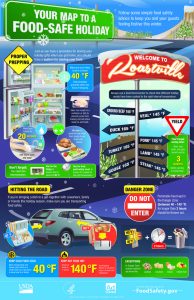The year may be coming to the end, but the celebrations and food are not. During the holidays, food can be handled in a variety of ways when it comes to preparing, storing and delivering. The more times that food is handled, the more risks it can provide for foodborne illnesses. Foodborne illnesses come from food that is treated unsafely, which can lead to an upset stomach abdominal cramps, nausea and vomiting diarrhea, fever or dehydration. Every year, the Centers for Disease Control and Prevention estimates about 48 million cases of confirmed foodborne illnesses occur. However, following simple tips and precautions can decrease the risks of obtaining them:
- Use separate cutting boards for raw meat and ready-to-eat items like vegetables or bread
- Prepare uncooked recipes before recipes requiring raw meat to reduce cross contamination. Store them out of the way while preparing meat dishes to ensure they don’t become contaminated after preparation.
- Hot foods should remain above 140˚F and cold items should remain below 40˚F. Discard perishable foods if left out for 2 hours of more in the danger zone (40˚F- 140˚F).
- Use a food thermometer to check internal temperatures of dishes to ensure it is safe to eat.
- Fresh beef, pork, veal, and lamb should be cooked to 145 ˚F with a three-minute rest time
- Fish should be cooked to 145 ˚F
- Ground beef, veal and lamb should be cooked to 160 ˚F
- Egg dishes should be cooked to 160 ˚F
- All poultry should be cooked to 165 ˚F
During the holidays, it seems like food is handled in more ways than usual. For instance, mailing food as a gift such as fruit, cheese, cured meats, etc, is a popular choice because it is convenient, yet meaningful. However, there are many protocols that must be followed to ensure mail order food safety. These protocols can be found on the USDA website: (https://www.fsis.usda.gov/wps/portal/fsis/topics/food-safety-education/get-answers/food-safety-fact-sheets/safe-food-handling/mail-order-food-safety/).
Another trend during the holidays is inviting family/friends to a holiday buffet party. This is a festive time that allows giving and sharing of homemade recipes. However, this is also an invitation for bacteria getting into food that is left out for long periods of time. This can be avoided by using specific shallow containers, following the two-hour rule, cooking food thoroughly, etc. To learn more about safe holiday buffets, read more on the USDA website, (https://www.fsis.usda.gov/wps/portal/fsis/topics/food-safety-education/get-answers/food-safety-fact-sheets/seasonal-food-safety/holiday-or-party-buffets/CT_Index).
The holidays may be the time of giving, but NOT the time of giving foodborne illnesses. Treat your food with care to bring safe food to your table. To learn more about food safety, read more on the USDA website. (foodsafety.gov)
Submitted by Steph Grasso, VT Department of Human Nutrition, Foods and Exercise

